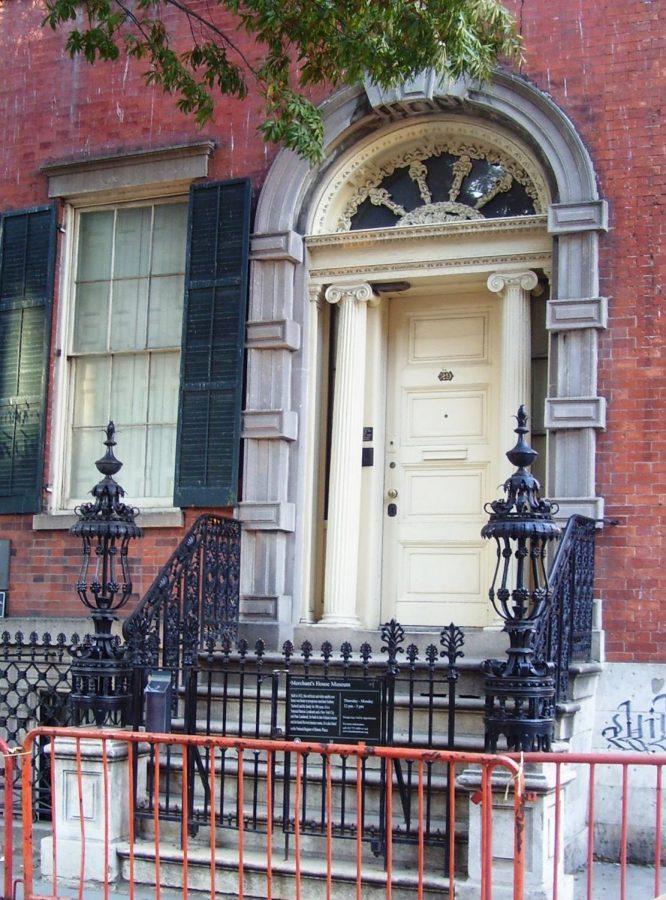Proposed East Village Hotel Development Threatens Historic Merchant’s House
The exterior of the Merchant’s House museum, which is likely to be damaged if the construction of a hotel next door proceeds.
May 2, 2018
Students who frequently find themselves on East 4th Street between Lafayette and Cooper Square might be used to passing the Merchant’s House Museum, often referred to as “Manhattan’s Most Haunted House.”
The townhouse, Manhattan’s first designated landmark, boasts a collection of preserved antiques belonging to its 19th century residents and a notorious history of alleged ghost sightings. Perhaps more frightening than its paranormal past, however, is the current threat against the historic house by the proposed construction of a hotel next door to the building.
In April 2014, the Landmarks Preservation Commission approved plans by Kalodop Park II Corporation to construct a hotel in the lot directly beside the Merchant’s House, at 27 E. 4th St. The hotel, which would be operated by an undisclosed European entity, would take the place of what is currently a garage used for food cart storage.
The eight-story structure would tower above the adjacent buildings, including the Merchant’s House. A call to arms posted on the museum’s website claims that the hotel would block sunlight from reaching the house’s garden and that the nearby construction would cause structural damage to the 186-year-old building.
The plans proposed by the developers have been criticized as examples of spot zoning, which Clinical Associate Professor of Art History and Urban Design and Architecture Studies Jon Ritter says students should take issue with.
“I think that NYU students should be engaged with this, if they have time to look up from their exams this time of year and worry about it,” Ritter said. “As soon as I start talking about heritage and identity and distinguishing characteristics that make Greenwich Village different from Midtown, or Abu Dhabi or London, I think young people seem quite open to that argument.”
In this case, the developers are attempting to amend Zoning Resolution 74-712 for this project, sidestepping regulations against a floor-level restaurant in the hotel and foregoing architectural measures to prevent the building from blocking sunlight.
“Trying to build a hotel next to Merchant’s House is already asking enough,” said SPS freshman Sarabeth Wong, who has been closely following the issue. “If the Merchant’s House Museum shifts by a sheer quarter of an inch, the original and irreplaceable 1832 ornamental plasterwork, considered the finest surviving in New York City, will suffer damage.”
A spokesperson from the Landmarks Preservation Commission said that the construction was approved on the condition that a protection plan for the neighboring Merchant’s House was developed, which includes on-site monitoring and the requirement that the developers of the hotel take safeguards to ensure they don’t damage any adjacent buildings. Still, there remains uncertainty as to whether the LPC will actually be able to enforce any of this.
“Landmarks [Preservation Committee] doesn’t have an enforcement arm,” Ritter said. “They don’t have the power to fine, or cease and desist. They don’t have a big stick. Because they’re not within the department of city planning, they’re kind of limited.”
The structurally fragile Merchant’s House can’t afford to wait and find out whether the developers will adhere to safety measures. In 1988, the museum suffered nearly $1 million in damage caused by the destruction of a nearby building and was forced to temporarily close.
“The current Landmarks Preservation Commission is not as careful as they should be about the city’s great surviving treasures,” Director of Urban Design and Architecture Studies and Clinical Professor Mosette Broderick said. “The old Merchant’s House is one of them.”
Past shady dealings of those involved with the development are also raising doubts about the integrity of the hotel project. In 2012, The Villager reported that two representatives of the hotel developers, Constantine Fotos and Edward Carroll, have previously plead guilty to illicit and deceptive practices and served jail time: Fotos in 2005 for illegally removing asbestos during a project and misleading a subsequent federal health and safety investigation, and Carroll in 2002 for obstructing justice and misleading a grand jury during a federal corruption case.
In addition to being located near the Washington Square campus, the Merchant’s House has another connection to the school: in the 1970’s, NYU graduate and staff architect Joseph Roberto worked pro bono as the volunteer restoration consultant for the museum and is often credited as having saved the building, which had been subject to vandalism and robbery in the 1950’s.
“Joe is the unsung hero of all this,” Broderick said.
The Merchant’s House website includes more information about actions supporters can take, including signing their petition, donating to the MHM legal fund, attending the upcoming pivotal Community Board 2 public hearing on May 9 at Grace Church School and even simply spreading the word.
“The more support we have, the more influence we have in this decision,” Wong said.
The public protestations against the threats against the Merchant’s House are also bringing vital awareness to the situation.
“The advocates and the museum itself will be on hand,” Ritter said. “Any violations or anything that falls below that level of due diligence, they will report that and call attention to it. You certainly have compliance built into the fact that there’s such passion around this issue.”
Email Serena Devi at [email protected].
























































































































































